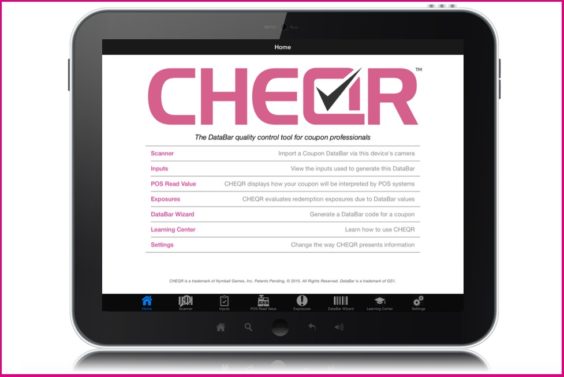Is it possible to condemn QSeer, while clandestinely benefiting from it at the same time? Many critics in the coupon industry have denounced the coupon-decoding app, accusing it of enabling coupon fraud. Yet some of those very critics have quietly, begrudgingly, downloaded the app in order to check how their own company’s coupons will scan at the store.
Now, the makers of QSeer want those users to come out of the shadows. They’ve introduced a new, separate version of the app that’s designed for the coupon industry, to help them avoid the very coupon errors that some QSeer users exploit.
CHEQR is now available on the App Store, exclusively for iPads. It’s a long-promised “professional” version of QSeer, that the app’s creators have promised ever since launching QSeer back in 2013. “It took a little longer than we planned, but we’re extremely happy with the finished product,” QSeer co-founder Katherine Cary told Coupons in the News.
Like QSeer itself, CHEQR scans a coupon’s bar code, and tells you how the coupon will scan at the store. If there are errors in the bar code that cause the coupon to scan in a way that doesn’t match the wording printed on the coupon, both apps will point it out. QSeer will tell you how the coupon can be used, and CHEQR will tell you how it can be fixed.
Critics, however, have said what QSeer really does is teach people how to misuse coupons, by revealing what products the coupons will “work” on. A coupon may be intended for a specific product, but successfully scan on a wide range of products that are not mentioned in the coupon’s wording.
It’s no wonder, then, that coupon abusers and members of online “glitch groups” have embraced QSeer as their tool of choice.
But Cary and her husband Brad have always insisted that misuse was not their intent when they created QSeer. And CHEQR, which is designed to help coupon issuers avoid the bar code errors that allow for coupon misuse, is meant to serve as proof of their good intentions.
DataBars, the longer bar codes that have now replaced the old UPC bar codes on coupons, contain much more information. The idea is to code them in such a way that they can only be redeemed precisely as described on the coupon itself.
But it doesn’t always work that way. “The DataBar concept is powerful, offering the possibility of automating the entire redemption process and virtually eliminating misredemption,” Cary said. Instead, mistakes are made in creating the complex bar codes. A lot of mistakes, according to Cary. “The problem that we face is that most DataBar issuers think that they do an excellent job, or they trust the people who create their DataBars.”
But some 70% of those DataBars, the Carys claim, contain errors that either “allow for the coupon to be redeemed in a manner other than the manufacturer’s intent as per the English words, or cause the coupon to be falsely rejected at point of sale when the consumer had met the stated terms.”
So CHEQR is designed to help coupon issuers determine what those errors are – and figure out how to fix them.
Similar to QSeer, CHEQR allows users to scan a coupon DataBar in order to see how the coupon will be read by a checkout scanner. Unlike QSeer, CHEQR then provides a full list of potential issues that may cause the coupon to be improperly redeemed, or incorrectly rejected. It’s designed to be used when a coupon is in the planning stages, before the coupon issuers go ahead and print them. “This product is not intended to replace their current processes,” Cary said. “CHEQR simply gives them a way to independently verify a DataBar, preferably before dropping an erroneous coupon in 20 million homes.”
An expanded version, CHEQR PRO, adds a DataBar creation tool. You just input the terms of the coupon you’re creating, to generate an accurate DataBar that can be imprinted on the coupon.
It’s like QSeer on steroids. So is it something that should be freely available on the App Store? If some couponers are using QSeer to misuse coupons, wouldn’t they be able to use CHEQR PRO to generate their own bar codes and create their very own counterfeit coupons?
And the critics thought QSeer was dangerous.
But Cary contends that the chances of CHEQR PRO being used by would-be coupon counterfeiters are slim. “There are already free or cheap tools available on the internet to create DataBars,” she said. Those tools can help to create crude counterfeits, but CHEQR PRO has a broader range of capabilities, which “would not be of concern to the average counterfeiter.”
And at $249 for CHEQR, and $449 for CHEQR PRO, the price tags may not be appealing to the average counterfeiter, either.
But it’s money well spent for those who issue coupons, Cary believes. Especially those who have a tendency to mess them up.
When it comes to creating accurate DataBars, “a few manufacturers do an excellent job,” Cary said. “SC Johnson leads the world with nearly 100% accuracy, whereas General Mills is the polar opposite with an average of more than one error per coupon.” In a spot check of one recent SmartSource insert, Cary said QSeer and CHEQR found that General Mills issued “8 coupons with a total of 19 major errors. I am confident that CHEQR could save them easily $10 million annually in misredemption costs!”
The Carys hope CHEQR helps to win over the critics who’ve questioned QSeer. And if it’s widely adopted, CHEQR could ultimately eliminate the need for QSeer altogether. If the Carys have their way, coupon DataBars will reflect exactly what’s written on the coupon – 100% of the time. Then there would be no need for a QSeer app that tells you how a coupon can “really” be used, rightly or wrongly. All along, after all, the Carys say their real goal and ultimate hope was to help fix the problems that QSeer exposes.
So could this mean QSeer will eventually become obsolete? If so, then the critics may get their wish.
But only after the Carys get theirs.
















